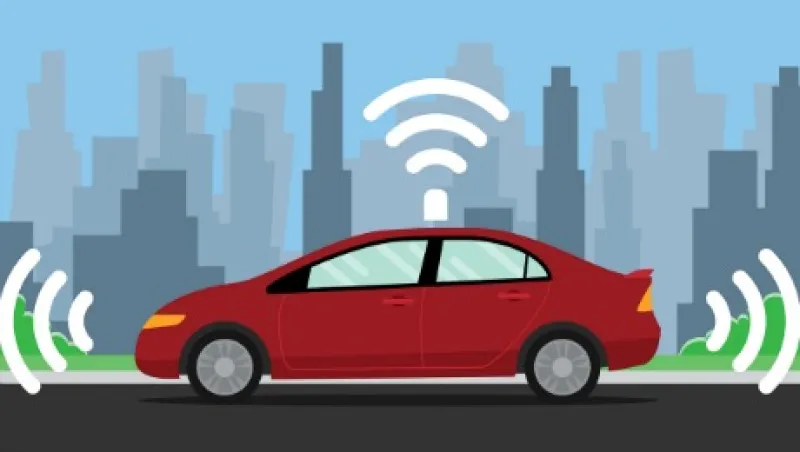Studies of the impact of driverless vehicles on the auto insurance industry over the next 25 years read like warnings to dinosaurs on the eve of extinction. “A seismic shift,” declared a Barclays report last September. Traditional insurance business models will be “flipped upside down,” KPMG asserted a month later.
“The death of auto insurance is being greatly exaggerated,” retorts James Lynch, chief actuary for the Insurance Information Institute (III), the industry’s main lobbying group. “A lot of these futuristic reports have gotten way out in front of reality.”
True, insurance claims are falling by more than 7 percent for new vehicles equipped with cameras that eliminate blind spots, automatic brakes that stop cars when drivers fail to recognize an imminent crash situation, and other safety breakthroughs linked to the development of autonomous driving, or AD. But premiums are holding steady. That means the auto insurance industry could be entering “a golden age of profits,” says Jay Gelb, New York–based insurance analyst for Barclays Capital. (See Autonomous Vehicles index.)
History backs up such middle-term optimism. When actuaries crank out auto insurance policies, they focus on two basic issues: the frequency of accidents and their severity — how much it will cost the insurer to repair vehicles and mend the injured.
Over the past half century, the frequency of accidents has fallen by about 50 percent thanks to mandatory safety belts, air bags and hydraulic brakes, among other innovations. But the cost of paying off claims has soared 1,600 percent since 1965. That’s because the price of auto parts and medical care is rising faster than the general inflation rate. “So for the auto insurance industry to shrink, claims frequency would have to fall a lot faster than the inflation rate of claims severity,” says the III’s Lynch. “And that’s unlikely.”
Still, futurologists assert that the safety advances and insurance industry disruptions caused by AD technology will be unlike any since the advent of automobiles in the late 19th century. According to KPMG, over the next 25 years there will be an 80 percent decline in accident frequency. “Insurance companies need to be concerned about reductions in accident frequency now because they are already starting to affect their business,” says Jerry Albright, co-author of the KPMG report.
Several leading insurers have recognized the industry risks ahead as people abandon individual car ownership and depend on fleets of driverless vehicles hailed through Uber or Lyft apps. In its 2014 annual report, Travelers warned shareholders that driverless cars and ride sharing “could disrupt the demand for our products from current customers, create coverage issues or impact the frequency or severity of losses, and we may not be able to respond effectively.”
According to a KPMG actuarial analysis, there will be a drastic shift from personal auto insurance to policies that cover commercial vehicles as driverless ride-sharing and truck fleets increase their market share. In 2013 personal auto accounted for 87 percent of losses covered by insurance, compared with 13 percent for commercial vehicles. In 2040 commercial vehicle loss coverage will have risen to 28 percent, compared with 58 percent for personal auto. The remaining 14 percent will be taken up by product liability. That category, which is statistically insignificant in today’s auto insurance lines, will grow as manufacturers are held liable for AD product failures. But the bad news for insurers, KPMG says, is that overall loss coverage could fall from $145 billion in 2013 to about $85 billion in 2040. There are several ways this income gap might be bridged. Barclays, in its 2015 report on global auto insurance, suggests there will be a rise over the next couple of decades in policies covering cyberrisks and cyberterrorism as hackers threaten AD commercial fleets by disrupting signals from dispatchers. According to a 2013 report by Boston Consulting Group, enormous troves of data that insurers collect from customers could be profitably used to improve fraud detection in accident claims or to offer one-time policies over mobile phones for vacation activities such as skiing and cycling. For large, diversified insurers, the easiest solution to the threats posed by AD development could be a shift away from auto insurance to other property/casualty lines.
In any case, there is still plenty of time for insurers to devise strategies to cope with the new AD era. “Ultimately, it could be devastating for the insurance industry,” says Meyer Shields, Baltimore-based insurance analyst for Keefe, Bruyette & Woods. “But it doesn’t make a whole lot of sense for insurers who are fighting for market share to worry about something two or three decades away, because even if the auto insurance industry disappears, there is a lot of money to be made between then and now.”
See also, “Driverless Cars, Start Your Engines.”






